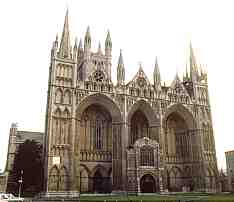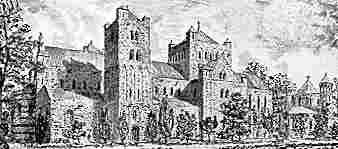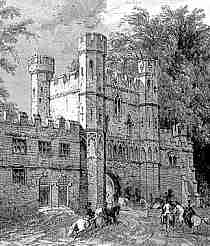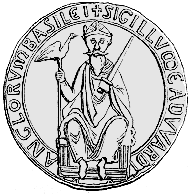



If you are looking at this page without frames, there is more information about medieval writing to be found by going to the home page (framed) or the site map (no frames).
| Monastic Cartularies (2) | ||
| Under the feudal landholding system, through all its modification during the middle ages, a private landholder did not own his property outright, and at his death he could not bequeath it to his heirs himself. The landholder was a tenant of the king, and at his death the crown determined the rightful heir. Ultimately, the king had the capacity at the death of a feudal tenant, or if one had annoyed him particularly by mounting a revolt or suchlike, to take control of the property. This was not true if the owner was the church. | ||
| The church acquired its property in perpetuity by charter from the king, or from gifts from private individuals aiming to secure the fate of their eternal souls, or sometimes just to work a good deal with the local monastery. This land was no longer under the control of the king. It was referred to as alienated. | ||
 |
Monasteries not only required the bit of real estate they were sitting on, they required income-producing land. After all, they had monks to feed, manuscripts to copy, treasures to collect and huge buildings to construct and maintain. They were feudal landholders themselves, and any rights they had acquired from the king or others were jealously guarded. | |
| West front of Peterborough Abbey church. | ||
| From Peterborough Abbey there survives a cartulary recording land transfers between farmers and serfs of the abbey. A rare survival, but that's right, the church had serfs. | ||
| The monasteries sought to protect the rights granted by previous monarchs by having their charter reaffirmed at the beginning of each reign. The production of cartularies was also an affirmative process. The trouble was, many of the foundations of monasteries, and the establishment of their rights, occurred before the development of systematic archiving. Foundation charters had been lost, or perhaps had never actually existed if the foundation had been by oral proclamation. | ||
 |
Conjectural reconstruction of Christ Church, Canterbury, around 1066. | |
| In England, 1066 was a big watershed date, and institutions founded before the time, such as Christ Church, Canterbury, made efforts to have all their privileges supposedly granted by pre-Conquest founders confirmed by succeeding monarchs. There was a thriving industry in forged charters, and Edward the Confessor seems to have written more charters after he was dead than he did in his lifetime. | ||
 |
Sometimes contentious issues revolved, not around property rights, but about relationships with other branches of the church, particularly the rights of local bishops to oversee monastic affairs. Battle Abbey, founded by William the Conqueror in thanks for his victory, had a dispute with the bishop of Chichester, and produced a number of forged charters containing claims that he was to have no jurisdiction over them. | |
| The gatehouse of battle Abbey, all that survives. | ||
| The production of a fully fledged forged charter, complete with fake copy of the great seal, was something of a major enterprise, although it was done. Much simpler, and more common, was to insert the missing documentation into a cartulary. The abbey of St Denis supported a case against the bishop of Paris with a mighty cartulary larded with forged charters going back to Merovingian times. Early charters have been added to cartularies, in a spirit of historical completeness, utilising information from monastic chronicles to create the missing documents. The odd clause has been added to documents in cartularies, just to clarify things. It was not really criminal, just the teething problems of this newfangled recordkeeping business. | ||
| With an original document, the detection of forgery can be accomplished by examination of the script, the diplomatic, the seal and any other hints of anachronism. This is not necessarily possible with cartulary entries, as some of the formulaic language is omitted, or scribes have changed them into the formulae of their time, rather than copying exactly what was written on the original. |
 |
|
| Seal of Edward the Confessor, now known to be from a forged matrix. | ||
| Nevertheless, the cartulary is a primary source from the medieval period. Even if it must be regarded with at least some circumspection as an absolutely accurate record of lost documents, it is an authentic record of how the monasteries regarded themselves, and their relationship with patrons, secular authority and ecclesiastical hierarchy. They are defining documents of identity. | ||
| The text of some English cartularies can be found in the University of Toronto's Deeds Project. A project on the early charters and cartularies of Worcester Cathedral, The Earliest Records of Worcester Cathedral, includes an online version of the St Wulfstan Cartulary with images and transcript, as well as some interesting discussion on the nature of cartularies. | ||
|
|
||
|
|
||
|
If you are looking at this page without frames, there is more information about medieval writing to be found by going to the home page (framed) or the site map (no frames). |
||